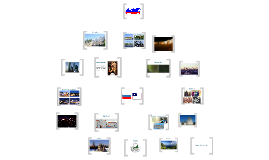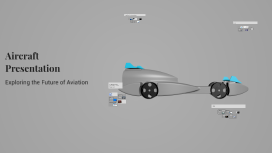Aircraft Presentation
Transcript: Technological Innovations Autonomous Flight Systems Electric Propulsion Advanced Materials Electric propulsion systems use electric motors and batteries to power aircraft, significantly reducing fuel consumption and emissions. These systems offer the potential for quieter operations, lower operational costs, and harness renewable energy sources. Autonomous flight systems integrate AI and advanced sensors to enhance pilot decision-making and reduce human error. These systems enable semi-autonomous capabilities like autopilot and can lead to fully autonomous commercial flights in the future. The use of advanced composite materials improves aircraft performance, reducing weight while increasing strength and durability. Innovations such as carbon fiber and titanium alloys enhance efficiency and fuel economy while enabling more complex designs. Sustainable Aviation Fuels Noise Reduction Technologies Sustainable aviation fuels (SAFs) are created from renewable resources, promising to reduce greenhouse gas emissions by up to 80%. They provide an immediate solution for greening the aviation sector while maintaining existing infrastructure. Noise reduction technologies such as advanced wing designs and sound-dampening materials contribute significantly to quieter flight operations. These innovations play a crucial role in minimizing the environmental impact of air travel and improving passenger comfort. Aircraft Design Aerodynamic Principles Propulsion Systems Aerodynamics is crucial for efficient aircraft design, impacting lift, drag, and fuel efficiency. Key principles include Bernoulli's theorem and Newton's third law, which explain how airfoil shapes contribute to flight performance. Modern aircraft utilize diverse propulsion systems, including turbofan and turbojet engines. These engines are designed for high thrust-to-weight ratios and fuel efficiency, driving advancements in flight capabilities. Avionics Integration Control Surfaces Avionics refers to the electronic systems used in aircraft, including navigation, communication, and flight control systems. Seamless integration of these technologies enhances safety and operational efficiency. Materials and Structure Control surfaces, like ailerons, elevators, and rudders, are essential for aircraft maneuverability. Their design contributes significantly to stability and pilot control during various phases of flight. Innovations in materials, such as composite materials, have transformed aircraft structure design, enhancing strength while reducing weight. These advancements result in increased fuel efficiency and improved performance. Aircraft Presentation Navigating Aviation Regulations: A Crucial Framework Exploring the Future of Aviation International Aviation Regulations The International Civil Aviation Organization (ICAO) establishes global standards and regulations governing international air travel. These regulations ensure uniformity in safety, airport operations, and air navigation across countries. Certification Processes Aircraft and their components must undergo rigorous certification processes to ensure they meet safety and operational standards. The certification is mandated by regulatory bodies and varies based on type and function of the aircraft. Safety Standards Safety standards set by organizations such as the Federal Aviation Administration (FAA) and European Union Aviation Safety Agency (EASA) dictate operational protocols, maintenance practices, and pilot training. Compliance with these standards minimizes risks associated with air travel. Emerging Policies Recent trends reveal emerging policies focusing on autonomous flight regulations and urban air mobility standards. As technology advances, regulators continually adapt policies to ensure safety while fostering innovation in aviation. Environmental Compliance Aviation faces increasing regulations aimed at reducing emissions and noise pollution. Compliance with environmental standards, like those established by ICAO's CORSIA, is essential for sustainable aviation practices. Future Trends AI and Machine Learning Urban Air Mobility Supersonic Travel AI and machine learning are transforming aviation by enhancing operational efficiency and safety. From predictive maintenance to smarter flight planning and cockpit automation, these technologies streamline processes and optimize performance. Urban Air Mobility (UAM) aims to revolutionize transportation in densely populated areas by utilizing electric vertical takeoff and landing (eVTOL) aircraft. This innovative approach promises to alleviate traffic congestion, reduce travel times, and provide efficient urban transport solutions. Recent advancements in technology have reignited interest in supersonic travel, with companies developing aircraft capable of flying faster than the speed of sound. This resurgence promises to cut long-distance travel times significantly, potentially changing international air travel dynamics. Global Collaboration

















